Obviously, your dirtbike isn’t the only thing vulnerable to impact in the wilderness. You have to do take care to protect your flesh, joints, and bones as well, hence this overview on the body armor that I have chosen to keep my hide from getting too rashed or banged up when I ride through woods near my Tennessee home.
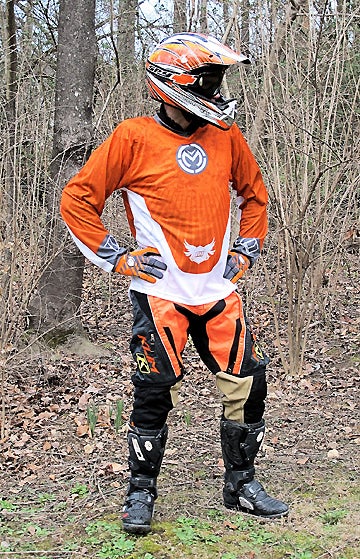 Right off the bat, let me make it clear that this isn’t a shootout to pick the best available kit. Instead, I’ll show examples of the gear that I have purchased and discuss what to look for as you make your own choices. What’s ideal in one setting, or for one type of riding, may not be ideal–or even appropriate–in another.
Right off the bat, let me make it clear that this isn’t a shootout to pick the best available kit. Instead, I’ll show examples of the gear that I have purchased and discuss what to look for as you make your own choices. What’s ideal in one setting, or for one type of riding, may not be ideal–or even appropriate–in another.
Because my off-roading tends to be on rocky, muddy, technical, mountain trails of the eastern persuasion, I’ll focus on what’s useful there. If you spend your time on tamer terrain, motocross tracks, or western desert, you may not need as much protection, or you may choose to make do with less because of competing priorities (e.g. minimizing weight or maximizing airflow and cooling). Or there may be something important where you ride that we don’t cover here. Tap the wisdom of local riders for specialized advice. Dual-sport types will need to consider how their pavement miles factor into their choices.
But since this is truly a 101-style story, we’ll assume considerable naiveté on your part. If you have zero dirt experience, here are the basics.
Helmet
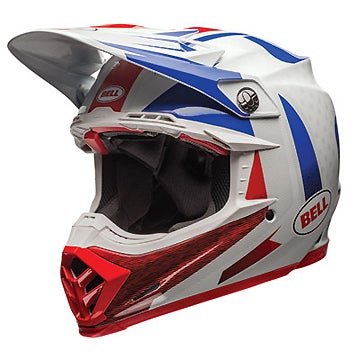
Before we start talking about gear, understand that off-road riding is especially perilous solo. If you have an accident on the street, you may be able to count on passersby to come to your aid. But if you or your bike is incapacitated in the middle of nowhere, there may be no one around to offer assistance. And, even if folks at home become concerned about your absence, how will they know where to look for you? So buddy up, take maps, first-aid, and a cell phone (sealed in a waterproof bag and cushioned so it won’t get crushed in a fall), and make someone aware of your planned route.
To protect that brain you just used, along with your vision and visage, a full-face off-road helmet is essential. Compared to their street-going cousins, these are usually lighter and come equipped with a sun-shading visor, but no face shield. Weight is extra onerous when you must constantly steady your head while covering rough ground (my necks is often the sorest body part after off-roading). Venting can be critical, too, as the physical exertion required off-road can be far greater than on the street, and speeds are generally slower, yielding much less airflow. Hence, we consider the ideal temperature range for dirt riding to be as much as 20-30 degrees cooler than for street riding.
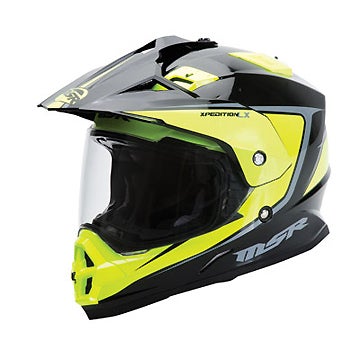
If you’re a streetbike rider who is really attached to your face shield or feel too claustrophobic when wearing goggles, consider a dual-sport- or adventure touring-style helmet. These combine the bill, ventilation and extended chin guard of a dirt helmet, with a built-in visor, like that of a street helmet; they may be the best of both worlds for some riders.
Goggles
Unlike street helmet visors, goggles protect eyes from all directions–including from underneath, where a surprising amount of debris can enter. To deal with dust and mud that accumulates on the front of goggles, you could just carry a rag and small squirt bottle. Or, you could use one of two systems developed for racing.
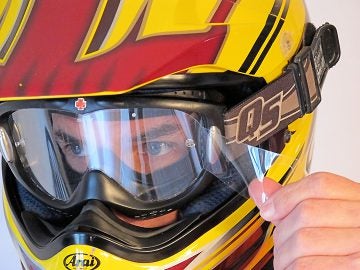
The other option, developed by Smith goggles, is the roll-off, a small film canister that mounts on each side of the goggle lens. A continuous strip of clear plastic gets wound across the lens from one canister into the other with a quick slap of a lever. Only the center portion of the lens is protected with this system, whereas tear-offs cover/restore the entire lens surface area. Still, roll offs are effective and there’s no litter. The hardware is an additional up-front expense, but the rolls of plastic are cheaper than tear-offs in the long run.
It’s crucial to find goggles that fit the contours of your face. What feels like a gentle squeeze on the bridge of your nose in a store may feel like a pair of vice-grips at the end of long ride. Goggles have foam-filled vents that should allow some filtered airflow to reduce fogging and supply a little cooling. Denser foam keeps more dust out, but also reduces airflow; unfortunately, the only way to find the right balance for your own riding is through trial and error. Darker replacement lenses can be very helpful in bright conditions, but may make deeply shaded terrain harder to read.
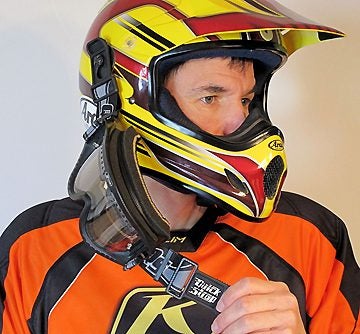
Neck Brace
Leatt pioneered this category, but several other companies have developed variations on the theme (see offerings from Alpinestars, EVS and Atlas). Each company claims to offer superlative protection, with differing advantages. We find it impossible to assess the relative merits of these devices, given that such opinions–to be meaningful–require biomechanical expertise we don’t possess.
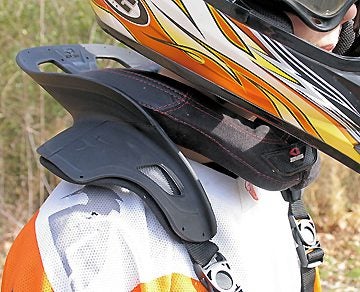
Some people find wearing a neck brace cumbersome, while others claim it quickly becomes as unnoticed while riding as any other gear. Many racers use these devices, yet there are still many who–though they could easily afford the hefty price tags–continue to ride without them.
Chest Protector & Kidney Belt
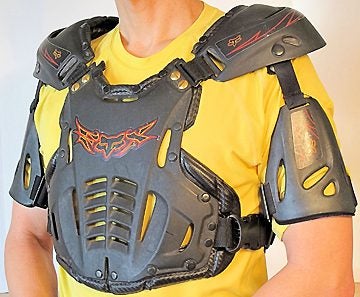
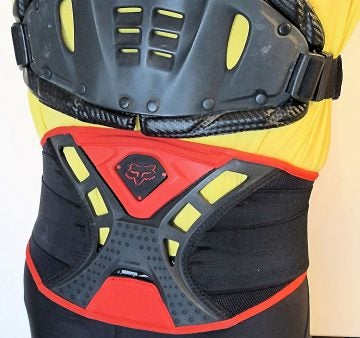
Kidney belts wrap around the lower torso and waist, and they are designed to protect the kidneys and other vital organs from damage due to the extreme vibration and shock encountered when riding in rough terrain,. They are usually fastened with one or a series of hook-and-loop connections at the front. Some kidney belts also offer a small amount of armor to help protect the lower spine in the event of an impact.
Elbow/Forearm Guards
It’s a very rare tumble that doesn’t involve significant impact to elbow or forearm; they’re simply the areas most likely to take the brunt of a sudden spill. Fortunately, armor here is among the least expensive. 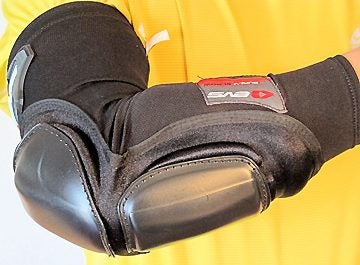
We have yet to find any such setup comfortable on a long ride, and much prefer elasticized sleeve versions. While sleeves allow less airflow, we’ll gladly pay that price for their huge comfort advantage. On hot days, the sleeve material can actually be an advantage, providing slow evaporative cooling after they’ve been splashed during a water crossing or deliberately soaked pre-ride. And on cold days, they’re obviously warmer than straps.
Gloves
Dirt gloves are quite different from street gloves, with virtually no armor or heavy leather padding. They’re typically designed for maximum flexibility, sensitivity and grip, with a stretchy, airy, woven nylon chassis and synthetic leather palms. 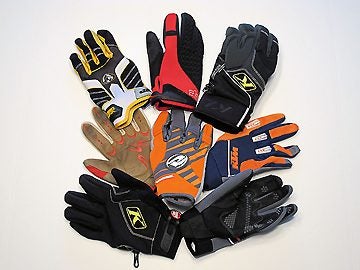
Although this isn’t a comparo article, to give a shout-out to Klim’s Inversion gloves, which feel warm in cold weather and cool in warm weather, while delivering good grip and a perfectly flexible fit. Their wind-stopping fabric makes them second choice to traditional dirt gloves on really hot days, and I’d take Klim’s PowerXross gloves’ superior insulation in frigid temps. But, for everything in between, no glove I’ve tried is as comfortable and versatile as the Inversions.
Knee Guards/Braces
Depending on your choice, knee protection can be had about as cheaply as elbow guards, or it can be the most expensive single piece of armor on your body. Simple hard plastic shields, backed with closed-cell foam and secured with elastic straps, can disperse frontal impacts sustained to the knee and shin, like you’d expect when riding through dense brush. But these do nothing to protect the joint from twisting and hyperextension, or guard it from side impacts, which are common in a fall.
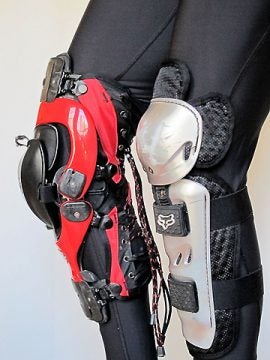
We’ve heard accounts of riders whose knee braces kept their knee safe, but transferred force to the mid-femur, resulting in a fracture there. As with neck braces, the argument could be made that any injury caused by the gear is much less problematic than the injury prevented by the gear. In most cases, fixing a fractured femur is far simpler than rehabbing a blown-out knee. I consider knee braces much less controversial than neck braces, and highly recommend them; I feel naked without mine.
Boots
Dirt boots are second only to ski boots in bulk, weight and clumsiness when walking around. But, like ski boots, they can offer just the right flexibility and sensitivity during their intended use. Construction typically includes hard plastic shin guards, three or four cantilevered buckles on adjustable nylon straps, and thick/hard soles to provide a) support while standing on pegs, and b) protection from forces that could squeeze the foot from the sides. 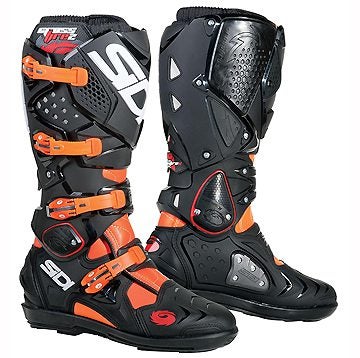
Although they’re expensive, I use Sidi’s Crossfire SRS model which is constantly being updated. The Sidis’ soles can be replaced by the user–a very useful feature, given that lots of standing on a dirtbike’s cleated footpegs can easily destroy a boot’s sole long before the rest of the boot wears out. A few boots from other manufacturers have small replaceable sections of sole where footpegs chew most.
Pants, Jerseys & Jackets
While technically not armor, these garments do serve protective functions. While some jerseys have mesh ventilation panels, all provide a layer of insulation from the elements (including the sun) and some feature a thicker/tighter weave for cold temps.
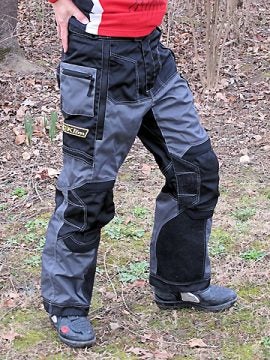
Almost all riding pants have stretch panels above the knee to enhance freedom of movement. If you wear knee braces, it’s important to try on pants with the braces in place, as width in their knees may be too restrictive for your braces. Really sophisticated riding pants have reinforcements in the knee area to compensate for the increased fabric stresses caused by knee braces.
There’s a growing range of choices available in off-road jackets, no doubt due to the expansion of the adventure touring market. Look for such features as zip-off sleeves, cargo and hand-warmer pockets, built-in pouches that swallow the whole garment for quick storage, zippered ventilation, hydration system pockets or ports, and breathable waterproof membranes. Some provision for skirt expansion (e.g. a two-way main zipper that opens from top or bottom, or zippered side gussets) can also be a big plus for increased comfort in the seated position, or to allow the jacket to fit over a fanny pack.
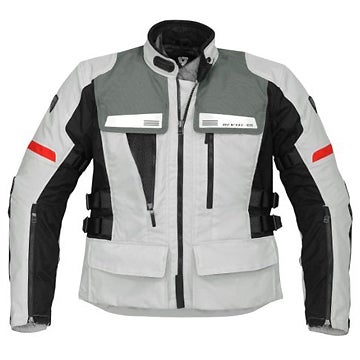
Although it’s unquestionably a fashion disaster, I’ve taken to wearing an over-sized jacket on top of all my usual gear when it gets really cold and wet. My concealed Camelbak makes me look like Quasimodo, but I love the simplified clean-up after a messy ride. When the weather merely threatens, I keep a minimalist shell handy: it’s easy to stow and makes riding in a downpour a lot less miserable. It can also be invaluable as a windbreaker after an unexpected splashing in cold weather.
Pardon the pun, but that about covers it. My primary recommendation is that beginning dirtbike riders get started the right way by protecting themselves with dirtbike-specific riding gear that is designed by companies that have a mountain of experience and data to support their commitment to improve rider safety. The one thing I know for sure is that if you ride dirtbikes long enough, you are going to crash, and wearing proper safety gear can be the difference in avoiding a potentially serious injury.
Personally, I’d rather have it and not need it than the other way around. Of all the things I’ve hurt, pride still heals the quickest.
 Your Privacy Choices
Your Privacy Choices